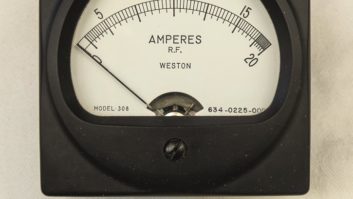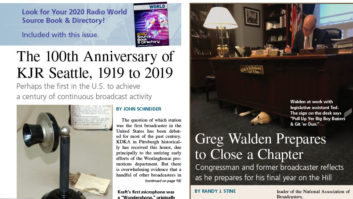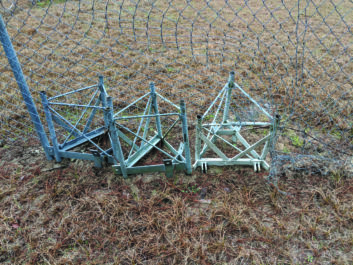
So when a vandal cuts through your tower fence, Fig. 1 (at right) is an example of how not to prevent further break-ins or correct the safety issue.
Yep, those are tower sections placed along the cut fencing. No names here, to protect the contract engineer who found this; it was not his work.
The FCC takes a harsh view on safety violations like this. An unsecured fence is certainly a safety issue. This is a good reminder to inspect all your station towers and fencing periodically.
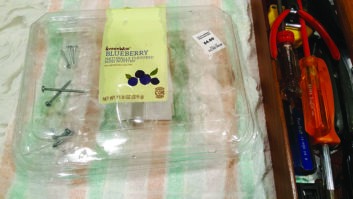
* * *
Brian Urban was in the audience for a recent episode of Kirk Harnack’s “This Week In Radio Tech” (TWIRT). I was a guest on the program, in which Kirk and I related a number of neat tips for engineers.
One of the tips was to use an aluminum muffin tin to hold small parts as you disassemble equipment. The depressions in the tin keeps parts organized, so they all get reinstalled in the proper order.
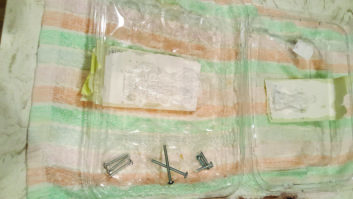
Brian, who is the coordinator for the Television Studio Lab at Austin Community College, had another suggestion: Grab your phone and take pictures as you disassemble things. Those pictures can be invaluable in showing how a complex assembly goes back together.
Don’t have a muffin tin available? Before you raid your kitchen, treat your staff to some of those grocery store-prepared muffins or mini-cupcakes (Fig. 2). They are sold in flexible plastic containers, usually with a hinged lid. Store the parts in the indentations in the plastic as shown in Fig. 3 and save the muffin tin for baking.
* * *
We so depend on the eagle-eyed readers of this column!
An example is California’s Robert Lilley, who pointed out that in our discussion about Windows 7 “not genuine” in November, the correct address is www.itechfever.com (the letter “i” was missing!) However, Googling “How to Fix Windows 7 not genuine error” will get you to the itech site, along with hundreds of others. Bob notes that this obviously is a popular subject!
Robert is still a consultant but these days he consults for radio-navigation systems. Still, he has collected a pretty good toolbox over the years, and it helps him keep the dishwasher running!
Robert has put together a couple of pages showcasing his on-air career in the late 1950s in West Virginia. We’ve bookmarked them for you at https://tinyurl.com/rw-lilley and https://tinyurl.com/rw-lilley2. You’ll enjoy the sites, especially if you like pictures of vintage studios and equipment.
* * *
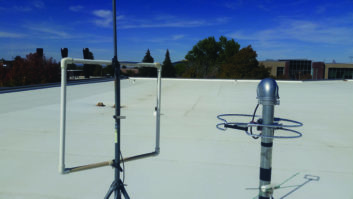
Lance Jackson is a technology engineer in the Communications Department of Southern Utah University in Cedar City, Utah. Lance enjoyed reading Ken Beckwith’s “how to” article on constructing a PVC EAS Receive Antenna in our Workbench column in late September.
Lance writes that he built something similar, pictured in Fig. 4, for the university’s station KSUU. In Lance’s iteration, he used 3/4-inch PVC pipe to form a simple square, two feet on each side. Like Ken, he used Cat-5e cable for the wire, looping it through the PVC pipe three or four turns. Since Cat-5e has four pairs of wires, fewer turns were required. Plus, since the Cat-5e cable pairs are already jacketed, you don’t have the problem of trying to snake multiple individual cables through the PVC tubing.
The wires were soldered the same way Ken did, and the antenna has been in service for 2 1/2 years now and works very well. Lance is one of many engineers who wrote and called, saying how useful these technical how-to articles are. We plan to bring you more (and we want your good ideas)!
See how easy it is to help other engineers? Where else can you earn recertification credit when you share a tip published in Workbench? Thank you for sharing your tips and high-resolution photos by sending them to johnpbisset@gmail.com.
John Bisset has spent 50 years in the broadcasting industry and is still learning. He handles western U.S. radio sales for the Telos Alliance. He holds CPBE certification with the Society of Broadcast Engineers and is a past recipient of the SBE’s Educator of the Year Award.
